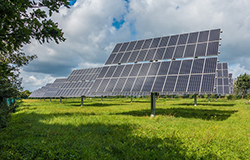 As concerns grow about the potential effects of global warming and people pay more attention to reducing their carbon footprints, green construction is becoming a larger part of the solution. A McGraw Hill study found that in 2008 the value of green construction starts might have been as high as $49 billion, and it could reach $140 billion by 2013.
As concerns grow about the potential effects of global warming and people pay more attention to reducing their carbon footprints, green construction is becoming a larger part of the solution. A McGraw Hill study found that in 2008 the value of green construction starts might have been as high as $49 billion, and it could reach $140 billion by 2013.
Building owners are attracted by energy cost savings, tax incentives, and the good publicity that comes from using an environmentally-friendly facility. Although green construction has become a lucrative business for contractors, it carries some risks that conventional construction methods do not have or have to a lesser extent.
Much of the difference between green construction and conventional methods is in areas of emphasis and materials. Green construction, because it is relatively new, uses new materials that might not have a proven long-term track record. The focus of a green building is energy conservation; objectives such as moisture control to prevent mold growth receive less attention.
Also, compared with conventional buildings, green buildings allow more air in from the outside, with potential impacts on building occupants’ health. Before construction begins, contractors must work with the project owner to identify the specific green objectives the owner wants to accomplish. With that knowledge, the contractor can determine how much additional risk the objectives present and create risk management plans to deal with it.
Price pressures can also be an issue. Green construction can be more expensive than conventional construction, yet project owners might be unwilling to pay a large premium for it. Contractors will be under pressure to hold costs down. This might cause them to take shortcuts that could increase the risk of creating defects in the building. The owner and contractor must work together to create a plan that balances cost savings with sound construction practices.
Green buildings carry a risk that their components might not perform as well over time as do those of conventional buildings. Because they stress innovative techniques and materials, green buildings use materials that have not undergone the years of testing that conventional materials have. Green construction favors using renewable resources and emphasizes insulation to reduce energy use.
Conventional buildings use materials with a history of good performance and emphasize keeping water and other elements out. To reduce performance risks, contractors should arrange for peer reviews that predict how materials will interact with other materials and building systems, predict how the building will hold up in actual use, and analyze waterproofing and humidity control capability.
Although green buildings are a relatively new concept, building owners expect them to perform at least as well as conventional buildings over the long term. Contractors who erect them might be vulnerable to lawsuits if a building fails to meet the U.S. Green Building Council standards. The USGBC offers its LEED certification to buildings that meet standards; the council can also revoke certification if it finds that a building is not performing as expected. Losing certification can harm a contractor’s reputation.
The peer reviews of materials and systems should help to reduce this risk. The green construction business is almost certain to grow rapidly during the next several years, and contractors will naturally want to take advantage of that. To reduce their risks, they should work with organizations such as the USGBC to get education and training on materials, construction techniques, and risk management. Together with peer review of materials and collaboration with project owners, these measures should help contractors complete quality and environmentally sound buildings.





